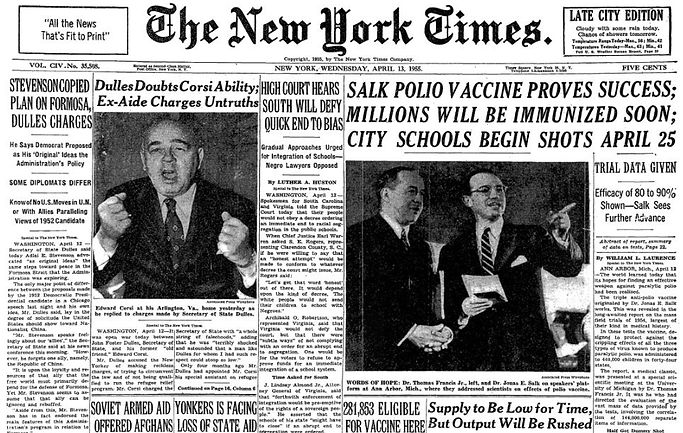Cultivation of the Vaccine
When first conducting experiments for a potential polio vaccine, monkey kidneys were needed for the production and testing of the vaccines. These monkeys were imported from Asia, and many of them soon died after arrival. Reducing dependence on imported monkeys soon became a priority for several research institutes. (1)
Paul van Hemert and Anton van Wezel developed a fermentor known as the "Bilthoven Unit" in which bacteria could be grown under standard conditions. This unit was able to grow large quantities of the poliovirus and monkey kidney cells, decreasing the dependence of imported monkeys. (2)

(7)
Doctor John Enders of Boston was able to cultivate all three antigenic types of the poliomyelitis virus in vitro using tissue culture derived from human embryos, uterus, and thyroid cells. The virus could then be demonstrated by the inoculation of monkeys or mice. (5)
Doctor Jonas Salk of Pittsburgh introduced another possible difficulty in creating a vaccination program. He reported that of the 100 strains of poliomyelitis virus typed in monkeys, 85 fell into one type, "Brunhilde," 12 fell into a second type, "Lansing," and 3 fell into a third type, "Leon." This discovery lead to the conclusion that any vaccine would require to be trivalent, increasing difficulties of manufacture. (4)
After several years of testing, the first polio vaccine was determined safe and effective on April 12, 1955. It was the largest clinical trial that had ever taken place during the time period. (3)

(8)

(9)
The creation of the polio vaccine in the 1950s demonstrated the power and further potential of immunization. By 1981, a record low of six cases of poliomyelitis was reported in the United States. (6)
Footnotes
1. Stuart Blume and Ingrid Geesink. "A Brief History of Polio Vaccines." Science 288, no. 5471 (2000): 1593-594. http://www.jstor.org/stable/3075465.
2. Ibid.
3. Tilli Tansey. "Medical History: Pioneer of Polio Eradication." Nature 520, no. 7549 (April 30, 2015): 620+. http://link.galegroup.com/apps/doc/A463816568/MSIC.
4. "Progress in Poliomyelitis." Canadian Journal of Public Health / Revue Canadienne De Sante'e Publique 42, no. 11 (1951): 486-88. http://www.jstor.org/stable/41980272
5. Ibid.
6. "The Development of Polio Vaccines." In Science and Its Times, edited by Neil
Schlager and Josh Lauer. Vol. 7. Detroit, MI: Gale, 2001. http://link.galegroup.com/apps/doc/CV2643450783/SCIC.
7. "A Brief History of Polio Vaccines"
8. New York Times OTD. "The front page #OTD in 1955. Polio vaccine is declared safe and effective. #nytimes." Twitter. April 13, 2016, 6:30 a.m. https://twitter.com/OnThisDayNYT/status/720242760830169089.
9. Darrell Salk. "Eradication of Poliomyelitis in the United States. I. Live Virus Vaccine-Associated and Wild Poliovirus Disease." Reviews of Infectious Diseases 2, no. 2 (1980): 228-42. http://www.jstor.org/stable/4452429.